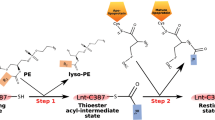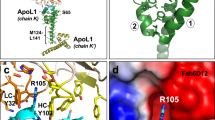Abstract
Apolipoprotein (apo) B-100, the major protein component in low density lipoprotein (LDL), is the ligand that binds to the LDL receptor1. It is important in the metabolism of LDL and elevated plasma levels of LDL-apo B are strongly associated with increased risk of coronary artery disease. Although apo B-100 is of great clinical and biological importance its primary structure has defied chemical elucidation, mainly because of its enormous size, insolubility, and tendency to aggregate2. Less than 5% of the apo B-100 sequence has been reported, despite the efforts of many laboratories over the past twenty years. Here we report the complete amino acid sequence of human apo B-100 as deducted by sequence analysis of complementary DNA clones; 2,366 of the 4,536 residues were also confirmed by direct sequencing of apo B-100 tryptic peptides. The distribution of trypsin-accessible and -inaccessible peptides of the protein on LDL is non-random and they can be grouped into 5 hypothetical domains. Of 20 potential N-glycosylation sites identified in the sequence, 13 were foundry direct peptide sequencing to be glycosylated, and 4 unglycosylated. Examination of the primary structure of apo B-100 reveals that it contains a large number of long (>70 residues) internal repeats and an even larger number of shorter ones, suggesting that the apo B-100 sequence was derived largely from internal duplications. Finally, using synthetic peptides of a specific region of apo B-100, we have identified a potential LDL receptor-binding domain (residues 3,345–3,381) which can bind to the LDL receptor and suppress 3-hydroxy-3-methyl-glutaryl coenzyme A (HMG-CoA) reductase activities in cultured human fibroblasts.
This is a preview of subscription content, access via your institution
Access options
Subscribe to this journal
Receive 51 print issues and online access
$199.00 per year
only $3.90 per issue
Buy this article
- Purchase on Springer Link
- Instant access to full article PDF
Prices may be subject to local taxes which are calculated during checkout
Similar content being viewed by others
References
Brown, M. S. & Goldstein, J. L. Science 232, 34–47 (1986).
Bradley, W. A., Rhode, M. F. & Gotto, A. M. Jr. Ann. NY Acad. Sci. 348, 87–103 (1980).
Chen, S. W. et al. J. Biol. Chem. 261, 12918–12921 (1986).
Bull, H. B. & Breese, K. Arch. Biochem. Biophys. 161, 665–670 (1974).
Garnier, J., Osguthorpe, D. J. & Robson, B. J. molec. Biol. 120, 97–120 (1978).
Gotto, A. M. Jr., Levy, R. I. & Frederickson, D. S. Proc. natn. Acad. Sci. U.S.A. 60, 1436–1441 (1968).
Chen, G. C. & Kane, J. P. Biochemistry 14, 3357–3362 (1975).
Berg, K. Acta path. microbiol. Scand. 59, Suppl. 166–167, 369–382 (1963).
Albers, J. J., Adolphson, J. L. & Hazzard, W. R. J. Lipid Res. 18, 331–338 (1977).
Margolis, S. & Langdon, R. G. J. biol. Chem. 241, 485–493 (1966).
Chapman, M. J., Goldstein, S. & Mills, G. L. Eur. J. Biochem. 87, 475–488 (1978).
Wei, C.-F. et al. Proc. natn. Acad. Sci. U.S.A. 82, 7265–7269 (1985).
Karathanasis, S. K., Zannis, V. I. & Breslow, J. L. Proc. natn. Acad. Sci. U.S.A. 80, 6147–6151 (1983).
Boguski, M. S., Elshourbagy, N., Taylor, J. M. & Gordon, J. I. Proc. natn. Acad. Sci. U.S.A. 82, 992–996 (1985).
Luo, C. C., Li, W. H., Moore, M. N. & Chan, L. J. molec. Biol. 187, 325–340 (1986).
Lawrence, C. B., Goldman, D. A. & Hood, R. T. Bull. Math. Biol. (in the press).
Mahley, R. W. & Innerarity, T. L. Biochim. biophys. Acta 737, 197–222 (1983).
Innerarity, T. L., Weisgraber, K. H., Arnold, K. S., Rall, S. C. Jr & Mahley, R. W. J. biol. Chem. 259, 7261–7267 (1984).
Knott, T. J. et al. Science 230, 37–43 (1985).
Gianturco, S. H. & Bradley, W. A. Meth. Enzym. 128, 319–344 (1986).
Gianturco, S. H. et al. J. biol. Chem. 258, 4526–4533 (1983).
Bradley, W. A. et al. J. biol. Chem. 259, 14728–14735 (1984).
Bradley, W. A. & Gianturco, S. H. J. Lipid Res. 27, 40–48 (1986).
Havekes, L., Schouten, D., van Hinsbergh, V. & de Wit, E. Biochem. biophys. Res. Commun. 122, 785–790 (1984).
Fidge, N. H. & Nestel, P. J. J. biol. Chem. 260, 3570–3575 (1985).
Yang, C. Y., Pauly, E., Kratzin, H. & Hilschmann, N., Hoppe-Seyler's Z. Physiol. Chem. 362, 1131–1146 (1981).
Author information
Authors and Affiliations
Rights and permissions
About this article
Cite this article
Yang, CY., Chen, SH., Gianturco, S. et al. Sequence, structure, receptor-binding domains and internal repeats of human apolipoprotein B-100. Nature 323, 738–742 (1986). https://doi.org/10.1038/323738a0
Received:
Accepted:
Issue Date:
DOI: https://doi.org/10.1038/323738a0
This article is cited by
-
Identification of Receptor Ligands in Apo B100 Reveals Potential Functional Domains
The Protein Journal (2018)
-
Current knowledge on the mechanism of atherosclerosis and pro-atherosclerotic properties of oxysterols
Lipids in Health and Disease (2017)
-
Structural analysis of APOB variants, p.(Arg3527Gln), p.(Arg1164Thr) and p.(Gln4494del), causing Familial Hypercholesterolaemia provides novel insights into variant pathogenicity
Scientific Reports (2015)
-
The Underlying Chemistry of Electronegative LDL’s Atherogenicity
Current Atherosclerosis Reports (2014)
-
Quartz crystal microbalance, a valuable tool for elucidation of interactions between apoB-100 peptides and extracellular matrix components
Analytical and Bioanalytical Chemistry (2010)
Comments
By submitting a comment you agree to abide by our Terms and Community Guidelines. If you find something abusive or that does not comply with our terms or guidelines please flag it as inappropriate.



